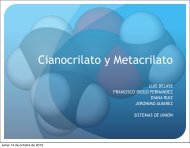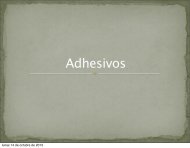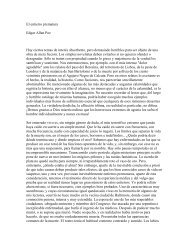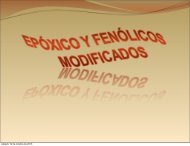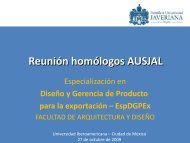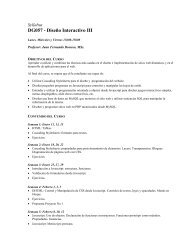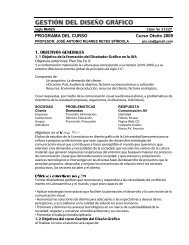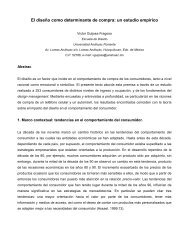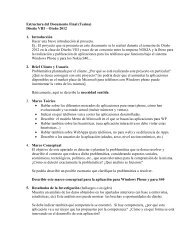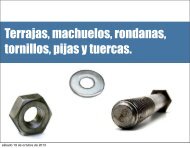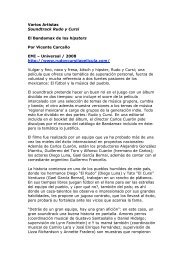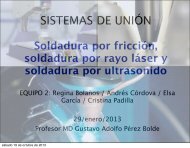Diseño sin FronterasThe Color in Dress was a dress created by the <strong>de</strong>signersSoepboer Berber and Michiel Schuurman, which allow theuser to color the pattern, creating different and uniqueclothes.Moldable Mousehttp://poliuretano.wordpress.com/2008/01/31/mouse-moldavel-feito-<strong>de</strong>-poliuretano/acessed 3 june 2010The Lite-On’s Moldable Mouse is a conceptual project thatproposes the use of composite materials (clay, nylon andpolyurethane). The user can shape its contours to whateverform he <strong>de</strong>sires.Do hit Chair, Do Scratch Lamp, Do Breakhttp://boingboing.net/2008/05/02/droogs-do-hit-chair.htmlhttp://dailypoetics.typepad.com/.shared/image.html?/photos/uncategorized/2007/09/13/277605<strong>de</strong>13b36.jpg http://www.droog.com/projects/events/do-create-on-location/do-breakby-frank-tjepkema---peter-van-<strong>de</strong>r-jagt/accessed 3 june 2010The project “Do Create” created by the dutch companyDroog Design, offers some products that aim to promotethe “personal production” and encourages the user tointeract, play and interfere in the final shape of the object.AnalysisAnalyzing the examples above, we un<strong>de</strong>rstood that thereare different ways to <strong>de</strong>velop a product that allows the userinterference. The first three examples have the same essence:modules or interchangeable parts. The shelf Tangranand More are composed of modules that can be organizedby the user. Verb, in turn, has interchangeable parts thatwhen combined form and interfere with the function of theartifact.The Lite-On’s mouse is malleable and allows the userinterference. The moldability concept is present on twoproducts of the project Do Create “Do Hit Chair” and “TheBreak”(Figures 6 and 7, respectively). In all these examples,the materiality of the artifact is presented to the user. So,he can make necessary interferences, without being tied topresets.Another way of personalization explored was the changeof the product’s interface, as illustrated in Figures 7 and9. In both projects, the user is invited to participate in thecreation of the product without necessarily interfering inform or function, but in the image that the object would bepresenting. In the case of “ DoScratch Lamp”, the operationof the <strong>de</strong>vice is subject to interference, only when the userscratches the black part, the light illuminates the place. Thedress “Color in Dress” has different patterns according tovisual interpretation of the user.Methodological insightsAfter analysis of these and other examples of artifactsthat allow self-expression, we believe that is importantto consi<strong>de</strong>r the concepts of moldability, modularity,interchangeability and interactive interfaces to <strong>de</strong>velopa project that stimulates the expressivity. We un<strong>de</strong>rstandthat the product needs to invite the user to manipulate andtransform it, and these concepts can make a simple artifactan object that invites interaction.Its is important to highlight that in all cases, user is a keypiece to the product configuration, participating, in thisway, in the construction of his i<strong>de</strong>ntity.Color in Dresshttp://www.ecouterre.com/diy-colour-in-dress-is-a-coloringbook-you-can-wear/acessed 28 <strong>de</strong>cember 2010The main conclusion of our study is that once wegive the chance to the user to <strong>de</strong>terminate the product’characteristics and express themselves, they35
MX Design Conference 2011participate more <strong>de</strong>eply of the social process ofdifferentiation and of being part of a group.BibliographyBARBOSA, Lívia. Socieda<strong>de</strong> <strong>de</strong> Consumo. 2 e.d. EditoraZahar: Rio <strong>de</strong> Janeiro, 2008.BLOM, Jan O., and Andrew F. Monk. 2003. “Theory of personalizationof appearance: Why users personalize theirPCs and mobile phones.” Human-Computer Interaction18:193-228. P313CAMPBELL, Colin. Eu compro, logo sei que existo: as basesmetafísicas do consumo mo<strong>de</strong>rno. In: Barbosa, Lígia; eCampbell, Colin (orgs). Cultura, Consumo e I<strong>de</strong>ntida<strong>de</strong>.Editora FGV: Rio <strong>de</strong> Janeiro, 2006.Csikszentmihalyi, M. (1995). Design & Or<strong>de</strong>r in Everyday Life.In: V. Margolin & R.CUCHE, Dennys. A noção <strong>de</strong> cultura nas ciências sociais.EDUSC: São Paulo, 1996.DAMÁSIO, A. (1996). O Erro <strong>de</strong> Descartes: emoção, razão e océrebro humano, SãoPaulo: Companhia das Letras.DAMÁSIO, A. (2004) Em busca <strong>de</strong> Espinosa: prazer e dorna ciência dos sentimentos. São Paulo: Companhia dasLetras.DAMAZIO, V. (2009). Some Lessons from Memory Artifactsof Everyday Life: toward the <strong>de</strong>sign of memorableproducts. IASDR 2009 Proceedings. http://www.iasdr2009.org/ap/Papers/Orally%20Presented%20Papers/Behavior/Some%20Lessons%20from%20Memory%20Artifacts%20of%20Everyday%20Life%20-%20toward%20the%20<strong>de</strong>sign%20of%20memorable%20products.pdfEstudos em Design, 2000. Design centrado no ser humano:uma necessida<strong>de</strong> cultural .p88MCCRACKEN, Grant. Cultura & Consumo: As novas abordagensa caráter simbólico dos bens e das ativida<strong>de</strong>s <strong>de</strong>consumo. Mauad: Rio <strong>de</strong> Janeiro, 2003.MENEZES, Cristiane Schifelbein <strong>de</strong>. Design & emoção: sobrea relação afetiva das pessoas com os objetos usadospela primeira vez. Rio <strong>de</strong> Janeiro, 2007. 95f. Dissertação(Mestrado em Artes e Design) – Pontifícia Universida<strong>de</strong>Católica do Rio <strong>de</strong> Janeiro.MOCELLIM, Alan. Simmel e Bauman: mo<strong>de</strong>rnida<strong>de</strong> eindividualização. Revista Eletrônica dos Pós-Graduandosem Sociologia Política da UFSC Vol. 4 n. 1 (1),agosto-<strong>de</strong>zembro/2007NORMAN, Donald A. Emotional Design: Why we love (orhate) everyday things. New York: Basic Books, 2004.ROCHA, Everardo P. Coisas estranhas, coisas banais: notaspara uma reflexão sobre o consumo. In: Rocha, Everardo;Men<strong>de</strong>s <strong>de</strong> Almeida, Maria Isabel; e Eugenio, Fernanda(orgs.). Comunicação, Consumo e Espaço Urbano: novassensibilida<strong>de</strong>s nas culturas jovens. Editora PUC Rio eMauad X: Rio <strong>de</strong> Janeiro, 2006.ROCHA, Everardo P. Guimarães. Magia e Capitalismo.Um estudo antropológico da publicida<strong>de</strong>. EditoraBrasiliense: São Paulo, 1985.SANTOS, Alan Bruno dos. Acervo <strong>de</strong> Design Emocional:perspectivas, produtos, referências teóricas e métodos.Rio <strong>de</strong> Janeiro, 2010. Relatório (Bolsa PIBIC/CNPq) –Pontifícia Universida<strong>de</strong> Católica do Rio <strong>de</strong> Janeiro.MUGGE, Ruth. Product Attachment.(Tese). Industrial DesignEngineering, Delft University of Technolgy, Delft, 2007a.artifacts and cultural inventions, important aspects inhuman’s cognitive <strong>de</strong>velopment.According to Bonsiepe (1997), Design is the domain inwhich interaction between user and product is structuredto facilitate effective actions. Fontoura (2002) says Design isan ample field that involves and to which different disciplinesconverge. It can be seen as an activity, as a process orun<strong>de</strong>rstanding in terms of its tangible results. It can be seenas a function of project management, as a project activity,as a conceptual activity, or even as a cultural phenomenon.It is viewed as a means to add value to things produced byhumans and also as a vehicle for social and political change.Design is an active process that influences society, creatingits material culture. From this perspective, Meurer, cited byFrascara (1997) says:The world in which we live is more than the matter that has solidifiedas form and remained over time. Its form is <strong>de</strong>fined by activity andaction is its center. If Design is conceived as oriented towards action,un<strong>de</strong>rstood as active interaction and creative change, it will notfocus on the object only as form. Quite the contrary, <strong>de</strong>signers shallconcern themselves with <strong>de</strong>veloping interactive process mo<strong>de</strong>ls inwhich object play an indisputable core role as a means for action.According to this vision, Design relates to the totality of humaninteraction’s concrete and intellectual spectrum, of interactionamong people, products and the world in which we live. (Meurer,apud Frascara, 1997, p. 220)The projects will be allocated to the local communities andthe initial actions will be focused on the following topics:36
- Page 2 and 3: MX Design Conference 2011Diseño si
- Page 4 and 5: ÍndiceCapeltic, una experiencia in
- Page 6 and 7: Diseño sin FronterasCapeltic, una
- Page 8 and 9: Diseño sin FronterasInvestigacione
- Page 10 and 11: Diseño sin Fronteras2) Una Empresa
- Page 12 and 13: Diseño sin Fronteras Se trabaja co
- Page 14 and 15: Diseño sin FronterasAhora bien, al
- Page 16 and 17: Diseño sin Fronteraslas personas a
- Page 18 and 19: Diseño sin FronterasDe esta manera
- Page 20 and 21: Diseño sin FronterasTercera fase:
- Page 22 and 23: Diseño sin FronterasDesign & Cultu
- Page 24 and 25: Diseño sin Fronteras Ideological p
- Page 26 and 27: Diseño sin Fronterasmain objective
- Page 28 and 29: Diseño sin FronterasHofstede´s cu
- Page 30 and 31: Diseño sin FronterasJORDAN, P., De
- Page 32 and 33: Diseño sin Fronterasour personalit
- Page 36 and 37: Diseño sin FronterasDesign in Teac
- Page 38 and 39: Diseño sin FronterasWe introduce t
- Page 40 and 41: Diseño sin Fronterasintellectual b
- Page 42 and 43: Diseño sin FronterasDesign Laborat
- Page 44 and 45: Diseño sin Fronterassustainable de
- Page 46 and 47: Diseño sin Fronteras4) Web design
- Page 48 and 49: Diseño sin Fronterasdemonstrating
- Page 50 and 51: Diseño sin Fronteraswith an encomp
- Page 52 and 53: Diseño sin FronterasDesign, Cultur
- Page 54 and 55: Diseño sin Fronterasb. Clothing: c
- Page 56 and 57: Diseño sin Fronterasappropriate fo
- Page 58 and 59: Diseño sin FronterasReferencesAPPA
- Page 60 and 61: Diseño sin Fronterasconocimiento 3
- Page 62 and 63: Diseño sin FronterasEntre los resu
- Page 64 and 65: Diseño sin FronterasOncología. Di
- Page 66 and 67: Diseño sin FronterasDistributed Co
- Page 68 and 69: Diseño sin Fronteras3 COLS: Web-ba
- Page 70 and 71: Diseño sin Fronterasoutcome, ‘pr
- Page 72 and 73: Diseño sin FronterasTable 1. List
- Page 74 and 75: Diseño sin Fronterasin which they
- Page 76 and 77: Diseño sin FronterasWithout attent
- Page 78 and 79: Diseño sin Fronterasexample, the d
- Page 80 and 81: Diseño sin Fronteras(fig.1). Despu
- Page 82 and 83: Diseño sin FronterasEl diseño est
- Page 84 and 85:
Diseño sin Fronteras1. Ser un medi
- Page 86 and 87:
Diseño sin FronterasEl diseño est
- Page 88 and 89:
Diseño sin Fronterascionados con l
- Page 90 and 91:
Diseño sin FronterasR&.)''$--)'"&+
- Page 92 and 93:
Diseño sin FronterasSegún la inve
- Page 94 and 95:
Diseño sin Fronterasde educación
- Page 96 and 97:
Diseño sin FronterasEnfoque y meto
- Page 98 and 99:
Diseño sin FronterasLos esquemas p
- Page 100 and 101:
Diseño sin FronterasWireframes - S
- Page 102 and 103:
Diseño sin FronterasEstos efectos
- Page 104 and 105:
Diseño sin Fronterasa special ques
- Page 106 and 107:
Diseño sin Fronteras“cool” tre
- Page 108 and 109:
Diseño sin Fronterasy por esta raz
- Page 110 and 111:
Diseño sin Fronterasindustrial. Va
- Page 112 and 113:
Diseño sin Fronterasmejor desempe
- Page 114 and 115:
Diseño sin Fronterasganancia econ
- Page 116 and 117:
Diseño sin Fronterasproposing solu
- Page 118 and 119:
Diseño sin Fronteras3. The first r
- Page 120 and 121:
Diseño sin FronterasInterdisciplin
- Page 122 and 123:
Diseño sin Fronterasu opor tunidad
- Page 124 and 125:
Diseño sin Fronterasla formulació
- Page 126 and 127:
Diseño sin FronterasInterdisciplin
- Page 128 and 129:
Diseño sin Fronterasreal de una or
- Page 130 and 131:
Diseño sin FronterasConclusionesHa
- Page 132 and 133:
Diseño sin FronterasEn numerosas o
- Page 134 and 135:
Diseño sin Fronterashace reflexion
- Page 136 and 137:
Diseño sin Fronterasocasiones no e
- Page 138 and 139:
Diseño sin Fronterascondición de
- Page 140 and 141:
Diseño sin FronterasLa psicología
- Page 142 and 143:
Diseño sin FronterasReferencias bi
- Page 144 and 145:
Diseño sin FronterasMetodologíaLa
- Page 146 and 147:
Diseño sin Fronterasvisión se com
- Page 148 and 149:
Diseño sin FronterasLa mediación
- Page 150 and 151:
Diseño sin Fronteraspermiten el ac
- Page 152 and 153:
Diseño sin Fronterassolo el 5% de
- Page 154 and 155:
Diseño sin FronterasFrías, J. (20
- Page 156 and 157:
Diseño sin FronterasLa noción de
- Page 158 and 159:
Diseño sin FronterasMirada de Muje
- Page 160 and 161:
Diseño sin Fronterasidentidades, d
- Page 162 and 163:
Diseño sin FronterasIntroducciónE
- Page 164 and 165:
Diseño sin Fronteraso revelan a tr
- Page 166 and 167:
Diseño sin FronterasCon respecto t
- Page 168 and 169:
Diseño sin Fronterasprofesional y
- Page 170 and 171:
Diseño sin Fronteras¿Qué es wiri
- Page 172 and 173:
Diseño sin FronterasWiring es una
- Page 174 and 175:
Diseño sin FronterasSources of inn
- Page 176 and 177:
Diseño sin FronterasFeatureDescrip
- Page 178 and 179:
Diseño sin FronterasEncoding relev
- Page 180 and 181:
Diseño sin FronterasThe new design
- Page 182 and 183:
Diseño sin Fronteraslearn by doing
- Page 184 and 185:
Diseño sin FronterasThe Open(d) Fr
- Page 186 and 187:
Diseño sin Fronterasdisseminate th
- Page 188 and 189:
Diseño sin Fronterascontrib- ute d
- Page 190 and 191:
Diseño sin FronterasThe same digit
- Page 192 and 193:
Diseño sin Fronterasque desde todo
- Page 194 and 195:
Diseño sin FronterasFigura 4 refer



